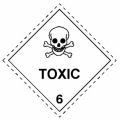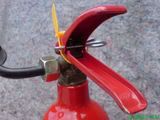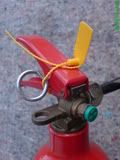I’d like to thank tiger65 again for spotting the mention of ADR in the case-study. 
I’m only looking at the ADR element of the job.
Here is the link to the case-study scenario:
http://www.ocr.org.uk/download/prm/ocr_39130_prm_vrq_unit_4_june_10.pdf
On exam day, I’d suggest that you read the questions carefully to judge whether RSA has already acquired the vehicles when answering any ADR related questions.
![]() RSA Plastics PLC will initially be subcontracting the work until it can acquire the necessary vehicles for its own fleet.
RSA Plastics PLC will initially be subcontracting the work until it can acquire the necessary vehicles for its own fleet.
Under ADR, checks MUST be made to ensure the bona-fides of any subcontractors used.
For instance, they should have an ‘O’ licence AND a DGSA and everything I’ve mentioned below.
RSA needs to appoint a qualified DGSA. There are no grandfather rights for DGSAs, nor is it a job that a boss can just ‘order’ a worker to do. DGSAs can only be qualified by passing the relevant exams and holding a current DGSA certificate, which is valid for five years. If a DGSA wishes to continue as a DGSA, they would need to sit the exams again in order to re-qualify and keep their certification valid.
You could be asked to list some of a DGSA’s functions:
- Monitoring the company’s compliance with ADR
- Advising the company on the carriage of dangerous goods
- Preparing an annual report to the company management
- Advising the company of ADR requirements when the company acquires vehicles
- Monitoring and recording the training of company employees (Including office and warehouse staff)
- Implementation of procedures regarding incidents during carriage/loading/unloading of dangerous goods
- Preparation of reports relating to serious accidents or infringements
This is not an exhaustive list, it covers only the main points. ![]()
The requirement to appoint a qualified DGSA can be fulfilled by any of the following methods:
- The boss/TM can take the exams and qualify
- One of RSA’s office staff can take the exams and qualify
- The DGSA function can be outsourced by appointing an external DGSA as a consultant.
The dangerous goods to be moved are:
The case study:
The NDC will be responsible for the collection of raw materials,
Dangerous Goods in packages makes up some 30% of all collected loads, particularly: **glues UN 2752, which are class 3 flammable liquids**
some of which are fully regulated dangerous goods,dyes and stains UN 3143 which are class 6.1 toxic
The dangerous goods come within full scope of the ADR Agreement and none of them is listed or mentioned in the CDG Road 2009 Regulations Derogations.
Since we’ve been told that the dangerous goods are all ‘within full scope,’ this keeps things relatively straightforward.
ADR Documentation
On board each ‘in scope’ vehicle there must be:
- The driver’s ADR certificate (aka a VTC) covering at least ‘packages’ and Classes 3 and 6. (MUST be original, no photocopies allowed!!)
- An ADR compliant transport document
- Instructions in Writing (MUST be printed in colour)
ADR vehicle equipment
On board each ‘in scope’ vehicle there must be:
- A wheel chock of a size suited to the maximum mass of the vehicle and to the diameter of the wheel;
- Two self-standing warning signs; (These can be either Cones OR warning triangles OR amber flashing lights)
- Eye rinsing liquid (Eye-wash)
General Personal Protective Equipment (PPE)
For each crew member on board each ‘in scope’ vehicle there must be:
- A warning vest (Hi-Viz clothing);
- Portable lighting apparatus; (Eg. a torch)
- A pair of protective gloves; (PVC gloves are best) and
- Eye protection (e.g. protective goggles).
Extra equipment requirements
For the carriage of glues UN 2752 Class 3
 Class 3 package label
Class 3 package label
Each ‘in scope’ vehicle must additionally have on board:
- A shovel;
- A drain seal;
- A collecting container made of plastics.
Extra equipment requirements
For the carriage of dyes and stains UN 3143 Class 6.1
 Class 6.1 package label
Class 6.1 package label
Each ‘in scope’ vehicle must additionally have on board:
- an emergency escape mask (aka a respirator) for each member of the vehicle crew.
![]() Check the question carefully, because if both substances are to be carried at the same time on the same vehicle, ALL of the above equipment will be necessary.
Check the question carefully, because if both substances are to be carried at the same time on the same vehicle, ALL of the above equipment will be necessary.
If the substances are carried on separate vehicles, please note that a respirator isn’t required when carrying only glues UN 2752 Class 3.
ADR fire-extinguisher requirements
![]() Unfortunately, the case study scenario doesn’t tell us which vehicles will be doing the collections of ‘in scope’ dangerous goods so please beware of the different minimum fire-extinguisher requirements…
Unfortunately, the case study scenario doesn’t tell us which vehicles will be doing the collections of ‘in scope’ dangerous goods so please beware of the different minimum fire-extinguisher requirements… ![]()
However, the case study scenario does tell us that RSA will be operating vehicles of differing GVWs. ![]()
As a general rule, ALL vehicles ‘in scope’ must have TWO ADR compliant fire-extinguishers on board
Fire-extinguisher compliance rules:
- Extinguishers must be of an approved type ie. the Kite Mark or the CE mark.
- Extinguishers must be periodically inspected and bear a label / sticker showing the next due date of inspection.
- Extinguishers must be fitted with a seal AND pin.
- Extinguishers must be protected from the effects of the weather.
- Extinguishers must be easily accessible.
 .
. .
. .
.
Using the fleet info provided, and not knowing which vehicles will be allocated to the ADR work, it leaves it open for you to be asked about which sizes of fire-extinguishers are needed for each GVW of vehicle. ![]()
ALL ‘in scope’ vehicles need the smaller (2kg) extinguisher as above, which MUST be of the ‘dry-powder’ type, PLUS one more extinguisher depending on the permitted G.V.W. of your vehicle as follows:
(The actual weight of dangerous goods that you’re carrying is irrelevant here ![]() )
)
Permitted G.V.W. up to and including 3,500 kgs needs ANOTHER 2kg extinguisher as above, making a total of 4kgs.
Permitted G.V.W. between more than 3,500kgs and up to and including 7,500kgs needs ANOTHER 6kg extinguisher making a total of 8kgs
Permitted G.V.W over 7,500kgs ie ANY LGV needs ANOTHER 10kg extinguisher making a total of 12kgs
Once the vehicle is an LGV, it doesn’t matter whether it’s a rigid, wag and drag or an artic
![]() So the “box vans operating at 6000kg GVW, occasionally drawing a trailer 2000kg GVW” mentioned in the scenario would need the 2kg + the 6kg when running solo, BUT when running with the trailer… the ‘in scope’ requirement changes to 2kg + 10kg, cos the GVW changes to 8,000 kg GVW.
So the “box vans operating at 6000kg GVW, occasionally drawing a trailer 2000kg GVW” mentioned in the scenario would need the 2kg + the 6kg when running solo, BUT when running with the trailer… the ‘in scope’ requirement changes to 2kg + 10kg, cos the GVW changes to 8,000 kg GVW.
Vehicle markings
This requirement is very straightforward…
For Classes 3 and/or 6.1, all ‘in scope’ vehicles’ require two PLAIN reflectorised orange coloured plates, one to be placed on the front of the vehicle, and one to be placed on rear of the vehicle. The size of the orange coloured plate is 40cm X 30cm
NO OTHER VEHICLE MARKINGS ARE REQUIRED.
 .
.
Polite request to posters on this topic…
This topic is designed to address the September 2010 operator CPC case-study scenario, so please keep any comments or questions strictly on this topic in order that we don’t confuse the folks attempting the case-study. Please read the case study scenario before posting. ![]()
Comments, suggestions and questions on this topic please chaps…
![]() Other questions can be put in the Safety and Law forum.
Other questions can be put in the Safety and Law forum.